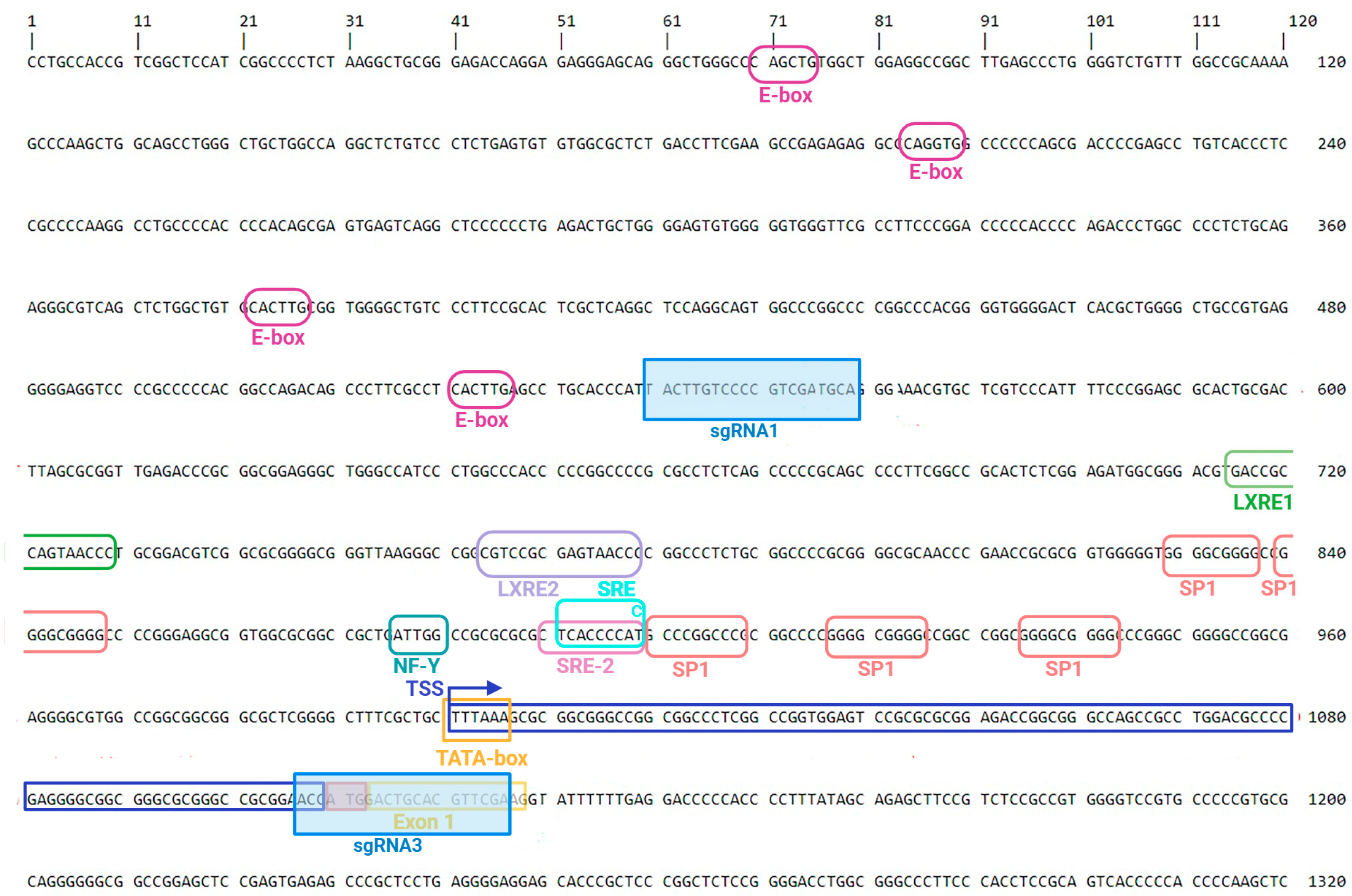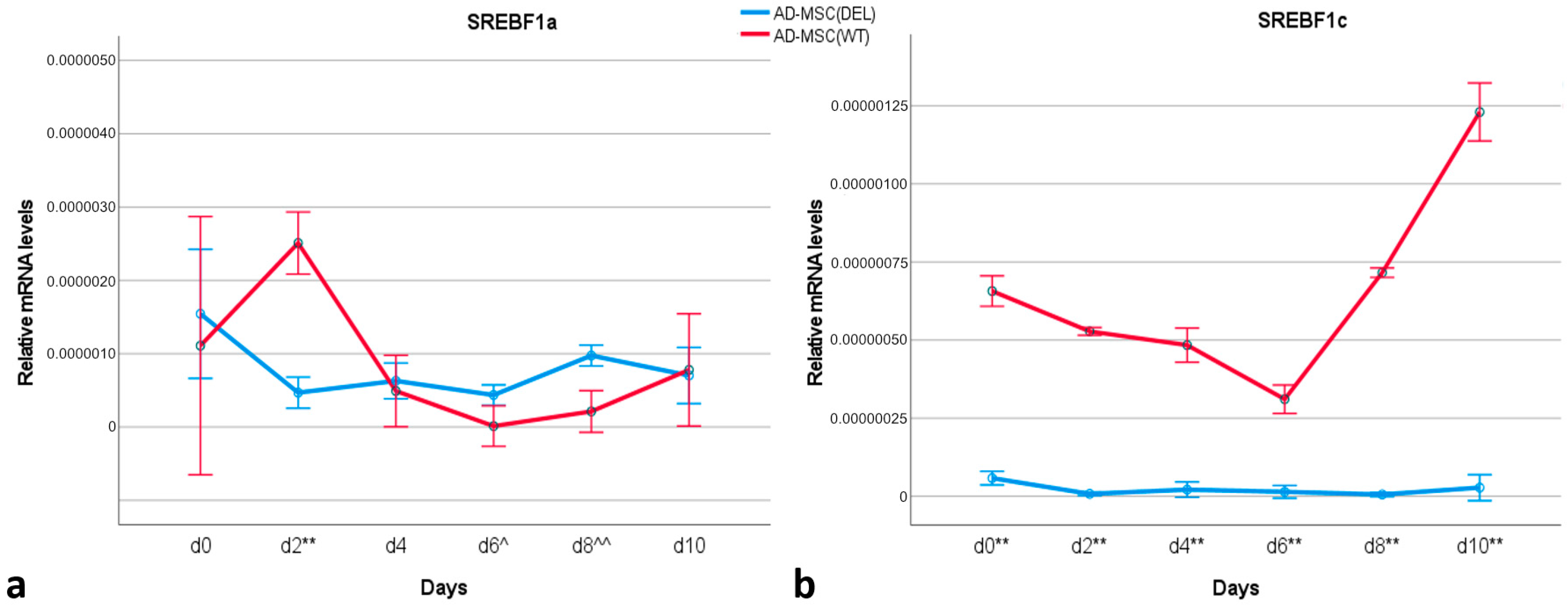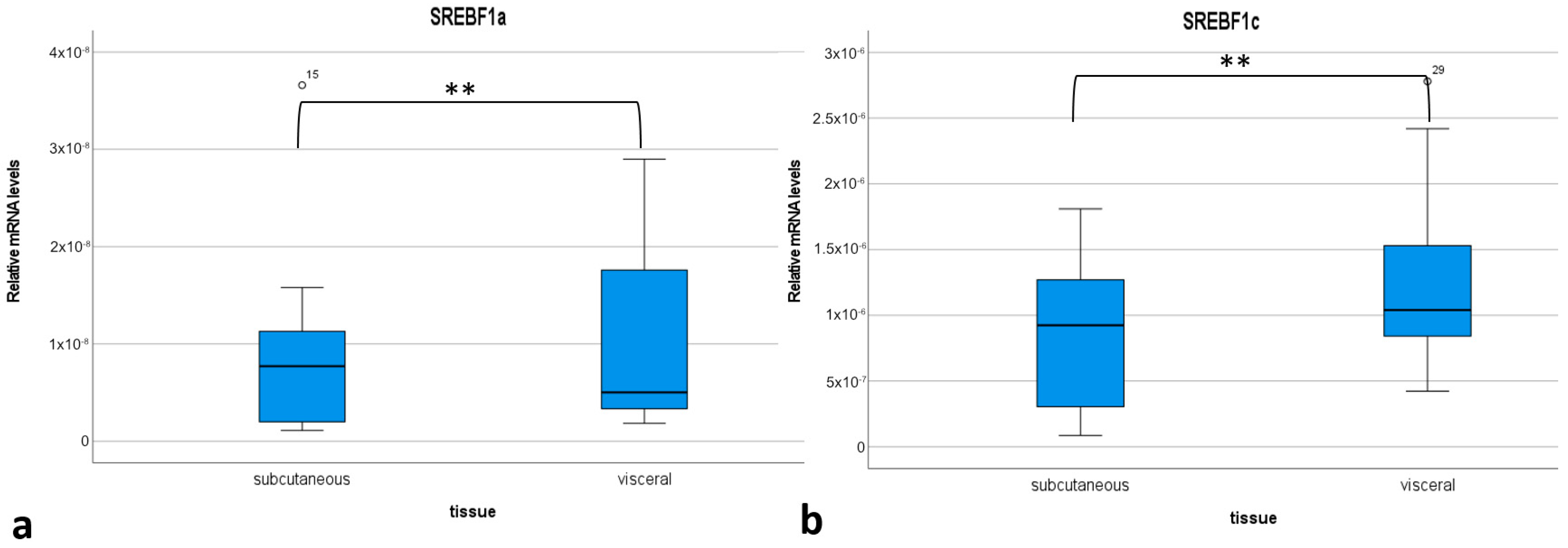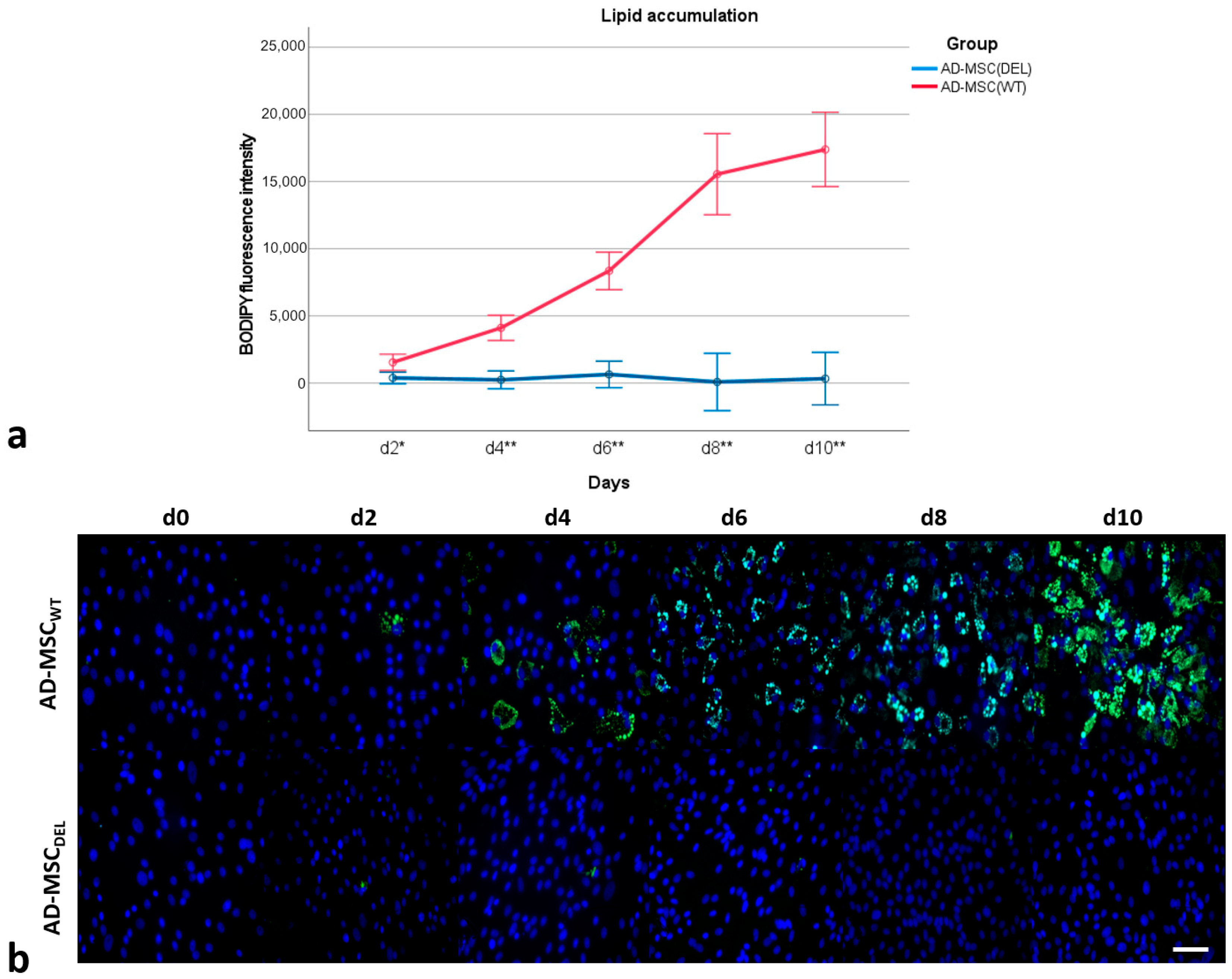Deciphering the Role of the SREBF1 Gene in the Transcriptional Regulation of Porcine Adipogenesis Using CRISPR/Cas9 Editing
Abstract
1. Introduction
2. Results
2.1. Characterization of the 5′-Regulatory Region in Porcine SREBF1 and the Introduction of a CRISPR/Cas9-Mediated Deletion in This Region
2.2. Characteristics of the Expression Profile of the SREBF1a and of SREBF1c Isoforms in Wide-Type Cells (AD-MSCWT) and in AD-MSC with Disrupted SREBF1c Gene (AD-MSCDEL) and Adipose Tissues
2.3. Monitoring of Lipid Droplet Accumulation in AD-MSCWT and in AD-MSCDEL
2.4. Expression of Key Adipogenic Genes in AD-MSCWT and AD-MSCDEL
3. Discussion
4. Materials and Methods
4.1. Cell Culture and Induction of Adipogenesis
4.2. Monitoring of Lipid Droplet Formation
4.3. gRNA Design and MSC Transfection
4.4. PCR Genotyping of AD-MSC Cells
4.5. Sanger DNA Sequencing
4.6. RNA Isolation, cDNA Synthesis, and Real-Time PCR
4.7. Experimental Control Procedures
4.8. Statistical Analysis
5. Conclusions
Supplementary Materials
Author Contributions
Funding
Institutional Review Board Statement
Informed Consent Statement
Data Availability Statement
Conflicts of Interest
References
- Horton, J.D. Sterol Regulatory Element-Binding Proteins: Transcriptional Activators of Lipid Synthesis. Biochem. Soc. Trans. 2002, 30, 1091–1095. [Google Scholar] [CrossRef] [PubMed]
- Eberlé, D.; Hegarty, B.; Bossard, P.; Ferré, P.; Foufelle, F. SREBP Transcription Factors: Master Regulators of Lipid Homeostasis. Biochimie 2004, 86, 839–848. [Google Scholar] [CrossRef] [PubMed]
- Felder, T.K.; Klein, K.; Patsch, W.; Oberkofler, H. A Novel SREBP-1 Splice Variant: Tissue Abundance and Transactivation Potency. Biochim. Biophys. Acta (BBA)-Gene Struct. Expr. 2005, 1731, 41–47. [Google Scholar] [CrossRef] [PubMed]
- Shimomura, I.; Shimano, H.; Horton, J.D.; Goldstein, J.L.; Brown, M.S. Differential Expression of Exons 1a and 1c in mRNAs for Sterol Regulatory Element Binding Protein-1 in Human and Mouse Organs and Cultured Cells. J. Clin. Investig. 1997, 99, 838–845. [Google Scholar] [CrossRef] [PubMed]
- Engelking, L.J.; Cantoria, M.J.; Xu, Y.; Liang, G. Developmental and Extrahepatic Physiological Functions of SREBP Pathway Genes in Mice. Semin. Cell Dev. Biol. 2018, 81, 98–109. [Google Scholar] [CrossRef]
- Madison, B.B. Srebp2: A Master Regulator of Sterol and Fatty Acid Synthesis. J. Lipid Res. 2016, 57, 333–335. [Google Scholar] [CrossRef]
- Vergnes, L.; Chin, R.G.; De Aguiar Vallim, T.; Fong, L.G.; Osborne, T.F.; Young, S.G.; Reue, K. SREBP-2-Deficient and Hypomorphic Mice Reveal Roles for SREBP-2 in Embryonic Development and SREBP-1c Expression. J. Lipid Res. 2016, 57, 410–421. [Google Scholar] [CrossRef]
- Bergen, W.G.; Mersmann, H.J. Comparative Aspects of Lipid Metabolism: Impact on Contemporary Research and Use of Animal Models. J. Nutr. 2005, 135, 2499–2502. [Google Scholar] [CrossRef]
- Gondret, F.; Ferré, P.; Dugail, I. ADD-1/SREBP-1 Is a Major Determinant of Tissue Differential Lipogenic Capacity in Mammalian and Avian Species. J. Lipid Res. 2001, 42, 106–113. [Google Scholar] [CrossRef]
- Jiang, J.; Xu, Z.; Han, X.; Wang, F.; Wang, L. The Pattern of Development for Gene Expression of Sterol Regulatory Element Binding Transcription Factor 1 in Pigs. Czech J. Anim. Sci. 2006, 51, 248–252. [Google Scholar] [CrossRef]
- Chen, J.; Yang, X.J.; Xia, D.; Chen, J.; Wegner, J.; Jiang, Z.; Zhao, R.Q. Sterol Regulatory Element Binding Transcription Factor 1 Expression and Genetic Polymorphism Significantly Affect Intramuscular Fat Deposition in the Longissimus Muscle of Erhualian and Sutai Pigs1. J. Anim. Sci. 2008, 86, 57–63. [Google Scholar] [CrossRef] [PubMed]
- Zhao, S.M.; Ren, L.J.; Chen, L.; Zhang, X.; Cheng, M.L.; Li, W.Z.; Zhang, Y.Y.; Gao, S.Z. Differential Expression of Lipid Metabolism Related Genes in Porcine Muscle Tissue Leading to Different Intramuscular Fat Deposition. Lipids 2009, 44, 1029. [Google Scholar] [CrossRef] [PubMed]
- Stachowiak, M.; Nowacka-Woszuk, J.; Szydlowski, M.; Switonski, M. The ACACA and SREBF1 Genes Are Promising Markers for Pig Carcass and Performance Traits, but Not for Fatty Acid Content in the Longissimus Dorsi Muscle and Adipose Tissue. Meat Sci. 2013, 95, 64–71. [Google Scholar] [CrossRef] [PubMed]
- Renaville, B.; Prandi, A.; Fan, B.; Sepulcri, A.; Rothschild, M.F.; Piasentier, E. Candidate Gene Marker Associations with Fatty Acid Profiles in Heavy Pigs. Meat Sci. 2013, 93, 495–500. [Google Scholar] [CrossRef] [PubMed]
- Malgwi, I.H.; Halas, V.; Grünvald, P.; Schiavon, S.; Jócsák, I. Genes Related to Fat Metabolism in Pigs and Intramuscular Fat Content of Pork: A Focus on Nutrigenetics and Nutrigenomics. Animals 2022, 12, 150. [Google Scholar] [CrossRef]
- Kim, J.B.; Wright, H.M.; Wright, M.; Spiegelman, B.M. ADD1/SREBP1 Activates PPARγ through the Production of Endogenous Ligand. Proc. Natl. Acad. Sci. USA 1998, 95, 4333–4337. [Google Scholar] [CrossRef]
- Kim, J.B.; Spiegelman, B.M. ADD1/SREBP1 Promotes Adipocyte Differentiation and Gene Expression Linked to Fatty Acid Metabolism. Genes Dev. 1996, 10, 1096–1107. [Google Scholar] [CrossRef]
- Rosen, E.D.; MacDougald, O.A. Adipocyte Differentiation from the inside Out. Nat. Rev. Mol. Cell Biol. 2006, 7, 885–896. [Google Scholar] [CrossRef]
- Farmer, S.R. Transcriptional Control of Adipocyte Formation. Cell Metab. 2006, 4, 263–273. [Google Scholar] [CrossRef]
- Siersbæk, R.; Nielsen, R.; Mandrup, S. Transcriptional Networks and Chromatin Remodeling Controlling Adipogenesis. Trends Endocrinol. Metab. 2012, 23, 56–64. [Google Scholar] [CrossRef]
- Shimomura, I.; Hammer, R.E.; Richardson, J.A.; Ikemoto, S.; Bashmakov, Y.; Goldstein, J.L.; Brown, M.S. Insulin Resistance and Diabetes Mellitus in Transgenic Mice Expressing Nuclear SREBP-1c in Adipose Tissue: Model for Congenital Generalized Lipodystrophy. Genes Dev. 1998, 12, 3182–3194. [Google Scholar] [CrossRef] [PubMed]
- Shimano, H.; Shimomura, I.; Hammer, R.E.; Herz, J.; Goldstein, J.L.; Brown, M.S.; Horton, J.D. Elevated Levels of SREBP-2 and Cholesterol Synthesis in Livers of Mice Homozygous for a Targeted Disruption of the SREBP-1 Gene. J. Clin. Investig. 1997, 100, 2115–2124. [Google Scholar] [CrossRef] [PubMed]
- Ayala-Sumuano, J.-T.; Velez-delValle, C.; Beltrán-Langarica, A.; Marsch-Moreno, M.; Cerbón-Solorzano, J.; Kuri-Harcuch, W. Srebf1a Is a Key Regulator of Transcriptional Control for Adipogenesis. Sci. Rep. 2011, 1, 178. [Google Scholar] [CrossRef] [PubMed]
- Fischer-Posovszky, P.; Newell, F.S.; Wabitsch, M.; Tornqvist, H.E. Human SGBS Cells—A Unique Tool for Studies of Human Fat Cell Biology. Obes. Facts 2008, 1, 184–189. [Google Scholar] [CrossRef] [PubMed]
- Alvarez, M.S.; Fernandez-Alvarez, A.; Cucarella, C.; Casado, M. Stable SREBP-1a Knockdown Decreases the Cell Proliferation Rate in Human Preadipocyte Cells without Inducing Senescence. Biochem. Biophys. Res. Commun. 2014, 447, 51–56. [Google Scholar] [CrossRef]
- Ruiz-Ojeda, F.; Rupérez, A.; Gomez-Llorente, C.; Gil, A.; Aguilera, C. Cell Models and Their Application for Studying Adipogenic Differentiation in Relation to Obesity: A Review. Int. J. Mol. Sci. 2016, 17, 1040. [Google Scholar] [CrossRef]
- Jo, J.; Gavrilova, O.; Pack, S.; Jou, W.; Mullen, S.; Sumner, A.E.; Cushman, S.W.; Periwal, V. Hypertrophy and/or Hyperplasia: Dynamics of Adipose Tissue Growth. PLoS Comput. Biol. 2009, 5, e1000324. [Google Scholar] [CrossRef]
- Louveau, I.; Perruchot, M.-H.; Bonnet, M.; Gondret, F. Invited Review: Pre- and Postnatal Adipose Tissue Development in Farm Animals: From Stem Cells to Adipocyte Physiology. Animal 2016, 10, 1839–1847. [Google Scholar] [CrossRef]
- Spurlock, M.E.; Gabler, N.K. The Development of Porcine Models of Obesity and the Metabolic Syndrome. J. Nutr. 2008, 138, 397–402. [Google Scholar] [CrossRef]
- Stachowiak, M.; Szczerbal, I.; Switonski, M. Genetics of Adiposity in Large Animal Models for Human Obesity—Studies on Pigs and Dogs. In Progress in Molecular Biology and Translational Science; Elsevier: Amsterdam, The Netherlands, 2016; Volume 140, pp. 233–270. ISBN 978-0-12-804615-9. [Google Scholar]
- Szczerbal, I.; Foster, H.A.; Bridger, J.M. The Spatial Repositioning of Adipogenesis Genes Is Correlated with Their Expression Status in a Porcine Mesenchymal Stem Cell Adipogenesis Model System. Chromosoma 2009, 118, 647–663. [Google Scholar] [CrossRef]
- Samulin, J.; Berget, I.; Grindflek, E.; Lien, S.; Sundvold, H. Changes in Lipid Metabolism Associated Gene Transcripts during Porcine Adipogenesis. Comp. Biochem. Physiol. B Biochem. Mol. Biol. 2009, 153, 8–17. [Google Scholar] [CrossRef] [PubMed]
- Wassef, M.; Luscan, A.; Battistella, A.; Le Corre, S.; Li, H.; Wallace, M.R.; Vidaud, M.; Margueron, R. Versatile and Precise Gene-Targeting Strategies for Functional Studies in Mammalian Cell Lines. Methods 2017, 121–122, 45–54. [Google Scholar] [CrossRef] [PubMed]
- Stachecka, J.; Nowacka-Woszuk, J.; Kolodziejski, P.A.; Szczerbal, I. The Importance of the Nuclear Positioning of the PPARG Gene for Its Expression during Porcine in Vitro Adipogenesis. Chromosome Res. 2019, 27, 271–284. [Google Scholar] [CrossRef] [PubMed]
- Bilinska, A.; Pszczola, M.; Stachowiak, M.; Stachecka, J.; Garbacz, F.; Aksoy, M.O.; Szczerbal, I. Droplet Digital PCR Quantification of Selected Intracellular and Extracellular microRNAs Reveals Changes in Their Expression Pattern during Porcine In Vitro Adipogenesis. Genes 2023, 14, 683. [Google Scholar] [CrossRef] [PubMed]
- Ishijima, Y.; Ohmori, S.; Uneme, A.; Aoki, Y.; Kobori, M.; Ohida, T.; Arai, M.; Hosaka, M.; Ohneda, K. The Gata2 Repression during 3T3-L1 Preadipocyte Differentiation Is Dependent on a Rapid Decrease in Histone Acetylation in Response to Glucocorticoid Receptor Activation. Mol. Cell. Endocrinol. 2019, 483, 39–49. [Google Scholar] [CrossRef]
- Merrett, J.E.; Bo, T.; Psaltis, P.J.; Proud, C.G. Identification of DNA Response Elements Regulating Expression of CCAAT/Enhancer-Binding Protein (C/EBP) β and δ and MAP Kinase-Interacting Kinases during Early Adipogenesis. Adipocyte 2020, 9, 427–442. [Google Scholar] [CrossRef]
- Yamamoto, Y.; Taniguchi, T.; Inazumi, T.; Iwamura, R.; Yoneda, K.; Odani-Kawabata, N.; Matsugi, T.; Sugimoto, Y.; Shams, N.K. Effects of the Selective EP2 Receptor Agonist Omidenepag on Adipocyte Differentiation in 3T3-L1 Cells. J. Ocul. Pharmacol. Ther. 2020, 36, 162–169. [Google Scholar] [CrossRef]
- Diaz-Velasquez, C.E.; Castro-Muñozledo, F.; Kuri-Harcuch, W. Staurosporine Rapidly Commits 3T3-F442A Cells to the Formation of Adipocytes by Activation of GSK-3β and Mobilization of Calcium. J. Cell. Biochem. 2008, 105, 147–157. [Google Scholar] [CrossRef]
- Tan, L.; Liu, X.; Dou, H.; Hou, Y. Characteristics and Regulation of Mesenchymal Stem Cell Plasticity by the Microenvironment—Specific Factors Involved in the Regulation of MSC Plasticity. Genes Dis. 2022, 9, 296–309. [Google Scholar] [CrossRef]
- Oberkofler, H.; Fukushima, N.; Esterbauer, H.; Krempler, F.; Patsch, W. Sterol Regulatory Element Binding Proteins: Relationship of Adipose Tissue Gene Expression with Obesity in Humans. Biochim. Biophys. Acta (BBA)-Gene Struct. Expr. 2002, 1575, 75–81. [Google Scholar] [CrossRef]
- Payne, V.A.; Au, W.-S.; Lowe, C.E.; Rahman, S.M.; Friedman, J.E.; O’Rahilly, S.; Rochford, J.J. C/EBP Transcription Factors Regulate SREBP1c Gene Expression during Adipogenesis. Biochem. J. 2010, 425, 215–224. [Google Scholar] [CrossRef] [PubMed]
- Lay, S.L.; Lefrère, I.; Trautwein, C.; Dugail, I.; Krief, S. Insulin and Sterol-Regulatory Element-Binding Protein-1c (SREBP-1C) Regulation of Gene Expression in 3T3-L1 Adipocytes. J. Biol. Chem. 2002, 277, 35625–35634. [Google Scholar] [CrossRef] [PubMed]
- Garin-Shkolnik, T.; Rudich, A.; Hotamisligil, G.S.; Rubinstein, M. FABP4 Attenuates PPARγ and Adipogenesis and Is Inversely Correlated with PPARγ in Adipose Tissues. Diabetes 2014, 63, 900–911. [Google Scholar] [CrossRef] [PubMed]
- Ambele, M.A.; Dhanraj, P.; Giles, R.; Pepper, M.S. Adipogenesis: A Complex Interplay of Multiple Molecular Determinants and Pathways. Int. J. Mol. Sci. 2020, 21, 4283. [Google Scholar] [CrossRef] [PubMed]
- Kobayashi, M.; Uta, S.; Otsubo, M.; Deguchi, Y.; Tagawa, R.; Mizunoe, Y.; Nakagawa, Y.; Shimano, H.; Higami, Y. Srebp-1c/Fgf21/Pgc-1α Axis Regulated by Leptin Signaling in Adipocytes—Possible Mechanism of Caloric Restriction-Associated Metabolic Remodeling of White Adipose Tissue. Nutrients 2020, 12, 2054. [Google Scholar] [CrossRef]
- Shochat, C.; Wang, Z.; Mo, C.; Nelson, S.; Donaka, R.; Huang, J.; Karasik, D.; Brotto, M. Deletion of SREBF1, a Functional Bone-Muscle Pleiotropic Gene, Alters Bone Density and Lipid Signaling in Zebrafish. Endocrinology 2021, 162, bqaa189. [Google Scholar] [CrossRef]
- Kurtz, S.; Lucas-Hahn, A.; Schlegelberger, B.; Göhring, G.; Niemann, H.; Mettenleiter, T.C.; Petersen, B. Knockout of the HMG Domain of the Porcine SRY Gene Causes Sex Reversal in Gene-Edited Pigs. Proc. Natl. Acad. Sci. USA 2021, 118, e2008743118. [Google Scholar] [CrossRef]
- Winogrodzki, T.; Metwaly, A.; Grodziecki, A.; Liang, W.; Klinger, B.; Flisikowska, T.; Fischer, K.; Flisikowski, K.; Steiger, K.; Haller, D.; et al. TNFΔARE Pigs: A Translational Crohn’s Disease Model. J. Crohn’s Colitis 2023, 17, 1128–1138. [Google Scholar] [CrossRef]
- Zhang, J.; Khazalwa, E.M.; Abkallo, H.M.; Zhou, Y.; Nie, X.; Ruan, J.; Zhao, C.; Wang, J.; Xu, J.; Li, X.; et al. The Advancements, Challenges, and Future Implications of the CRISPR/Cas9 System in Swine Research. J. Genet. Genom. 2021, 48, 347–360. [Google Scholar] [CrossRef]
- Tanihara, F.; Hirata, M.; Otoi, T. Current Status of the Application of Gene Editing in Pigs. J. Reprod. Dev. 2021, 67, 177–187. [Google Scholar] [CrossRef]
- Ruan, J.; Zhang, X.; Zhao, S.; Xie, S. Advances in CRISPR-Based Functional Genomics and Nucleic Acid Detection in Pigs. Front. Genet. 2022, 13, 891098. [Google Scholar] [CrossRef] [PubMed]
- Kamble, P.G.; Hetty, S.; Vranic, M.; Almby, K.; Castillejo-López, C.; Abalo, X.M.; Pereira, M.J.; Eriksson, J.W. Proof-of-Concept for CRISPR/Cas9 Gene Editing in Human Preadipocytes: Deletion of FKBP5 and PPARG and Effects on Adipocyte Differentiation and Metabolism. Sci. Rep. 2020, 10, 10565. [Google Scholar] [CrossRef] [PubMed]
- Lopez-Yus, M.; Frendo-Cumbo, S.; Del Moral-Bergos, R.; Garcia-Sobreviela, M.P.; Bernal-Monterde, V.; Rydén, M.; Lorente-Cebrian, S.; Arbones-Mainar, J.M. CRISPR/Cas9-Mediated Deletion of Adipocyte Genes Associated with NAFLD Alters Adipocyte Lipid Handling and Reduces Steatosis in Hepatocytes In Vitro. Am. J. Physiol.-Cell Physiol. 2023, 325, C1178–C1189. [Google Scholar] [CrossRef] [PubMed]
- Wang, C.-H.; Lundh, M.; Fu, A.; Kriszt, R.; Huang, T.L.; Lynes, M.D.; Leiria, L.O.; Shamsi, F.; Darcy, J.; Greenwood, B.P.; et al. CRISPR-Engineered Human Brown-like Adipocytes Prevent Diet-Induced Obesity and Ameliorate Metabolic Syndrome in Mice. Sci. Transl. Med. 2020, 12, eaaz8664. [Google Scholar] [CrossRef] [PubMed]
- Tsagkaraki, E.; Nicoloro, S.M.; DeSouza, T.; Solivan-Rivera, J.; Desai, A.; Lifshitz, L.M.; Shen, Y.; Kelly, M.; Guilherme, A.; Henriques, F.; et al. CRISPR-Enhanced Human Adipocyte Browning as Cell Therapy for Metabolic Disease. Nat. Commun. 2021, 12, 6931. [Google Scholar] [CrossRef]
- Wu, W.; Yin, Y.; Huang, J.; Yang, R.; Li, Q.; Pan, J.; Zhang, J. CRISPR/Cas9-Meditated Gene Knockout in Pigs Proves That LGALS12 Deficiency Suppresses the Proliferation and Differentiation of Porcine Adipocytes. Biochim. Biophys. Acta (BBA)-Mol. Cell Biol. Lipids 2024, 1869, 159424. [Google Scholar] [CrossRef]
- Vandesompele, J.; De Preter, K.; Pattyn, F.; Poppe, B.; Van Roy, N.; De Paepe, A.; Speleman, F. Accurate Normalization of Real-Time Quantitative RT-PCR Data by Geometric Averaging of Multiple Internal Control Genes. Genome Biol. 2002, 3, research0034.1. [Google Scholar] [CrossRef]
- Piórkowska, K.; Oczkowicz, M.; Różycki, M.; Ropka-Molik, K.; Kajtoch, A.P. Novel Porcine Housekeeping Genes for Real-Time RT-PCR Experiments Normalization in Adipose Tissue: Assessment of Leptin mRNA Quantity in Different Pig Breeds. Meat Sci. 2011, 87, 191–195. [Google Scholar] [CrossRef]








| Day 0 | Day 2 | Day 4 | Day 6 | Day 8 | Day 10 | |
|---|---|---|---|---|---|---|
| BODIPY | - | ↓ | ↓ | ↓ | ↓ | ↓ |
| SREBF1a | = | ↓ | = | ↑ | ↑ | = |
| SREBF1c | ↓ | ↓ | ↓ | ↓ | ↓ | ↓ |
| GATA2 | = | = | = | ↑ | = | = |
| CEBPD | ↓ | ↑ | ↓ | ↓ | = | = |
| CEBPB | ↓ | ↑ | ↓ | ↑ | ↑ | = |
| CEBPA | ↑ | ↓ | = | ↓ | ↓ | ↓ |
| PPRAG | ↓ | ↓ | ↓ | ↓ | ↓ | ↓ |
| FABP4 | ↑ | = | = | ↓ | = | ↓ |
Disclaimer/Publisher’s Note: The statements, opinions and data contained in all publications are solely those of the individual author(s) and contributor(s) and not of MDPI and/or the editor(s). MDPI and/or the editor(s) disclaim responsibility for any injury to people or property resulting from any ideas, methods, instructions or products referred to in the content. |
© 2024 by the authors. Licensee MDPI, Basel, Switzerland. This article is an open access article distributed under the terms and conditions of the Creative Commons Attribution (CC BY) license (https://creativecommons.org/licenses/by/4.0/).
Share and Cite
Aksoy, M.O.; Bilinska, A.; Stachowiak, M.; Flisikowska, T.; Szczerbal, I. Deciphering the Role of the SREBF1 Gene in the Transcriptional Regulation of Porcine Adipogenesis Using CRISPR/Cas9 Editing. Int. J. Mol. Sci. 2024, 25, 12677. https://doi.org/10.3390/ijms252312677
Aksoy MO, Bilinska A, Stachowiak M, Flisikowska T, Szczerbal I. Deciphering the Role of the SREBF1 Gene in the Transcriptional Regulation of Porcine Adipogenesis Using CRISPR/Cas9 Editing. International Journal of Molecular Sciences. 2024; 25(23):12677. https://doi.org/10.3390/ijms252312677
Chicago/Turabian StyleAksoy, Mehmet Onur, Adrianna Bilinska, Monika Stachowiak, Tatiana Flisikowska, and Izabela Szczerbal. 2024. "Deciphering the Role of the SREBF1 Gene in the Transcriptional Regulation of Porcine Adipogenesis Using CRISPR/Cas9 Editing" International Journal of Molecular Sciences 25, no. 23: 12677. https://doi.org/10.3390/ijms252312677
APA StyleAksoy, M. O., Bilinska, A., Stachowiak, M., Flisikowska, T., & Szczerbal, I. (2024). Deciphering the Role of the SREBF1 Gene in the Transcriptional Regulation of Porcine Adipogenesis Using CRISPR/Cas9 Editing. International Journal of Molecular Sciences, 25(23), 12677. https://doi.org/10.3390/ijms252312677






